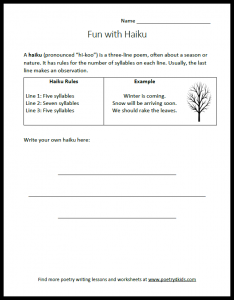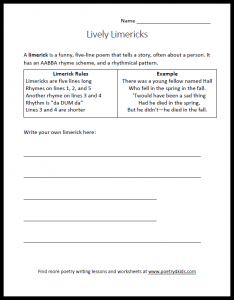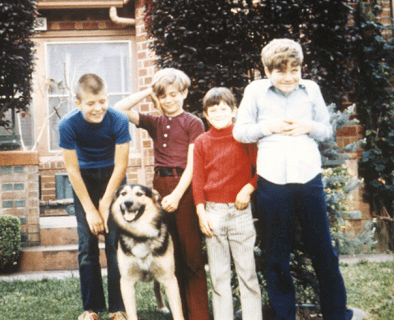
One of the easiest ways to write a funny poem of your own is to take any song you know – preferably a song that other people know too – and change the words to make your song. When you do this it’s called a “parody” or a “song parody” because it is a humorous imitation of the original song.
The first thing you will need to do to create your own parody is to pick a song. I recommend you choose a well-known children’s song such as “Take Me Out to the Ballgame” or “I’m a Little Teapot,” or a famous holiday song like “Jingle Bells,” rather than, say, a modern pop song. The reason is that more people will know the original tune, especially adults who may not be familiar with the latest songs on the radio.
Here is a list of songs to choose from (though there are many more than just these that will work well):
- Oh My Darling, Clementine
- The Itsy-Bitsy Spider
- On Top of Old Smokey
- Row, Row, Row Your Boat
- Twinkle, Twinkle, Little Star
- Miss Susie
- My Bonnie Lies Over the Ocean
- Yankee Doodle
Rewriting My Bonnie Lies Over the Ocean
Once you’ve picked a song, you’ll want to take a look at the original lyrics. For example, let’s look at the song “My Bonnie Lies Over the Ocean.” The original goes like this:
My Bonnie Lies Over the Ocean
My Bonnie lies over the ocean,
My Bonnie lies over the sea.
My Bonnie lies over the ocean,
Please bring back my Bonnie to me.Bring back, bring back,
Oh, bring back my Bonnie to me, to me.
Bring back, bring back,
Oh, bring back my Bonnie to me.
To change this into a new song, we will want to keep the same rhythm and the same rhyme pattern. That is, we’ll want to have the second line rhyme with the fourth line, just as in the original. We’ll probably also want to have something or someone lying on top of something or someone else. Let’s just change “Bonnie” and the thing that “Bonnie” is on.
For example, let’s say instead of “My Bonnie” I decide to have “My bunny” lie on top of something. What might that be? Perhaps, my bunny could lie on top of one of my other pets, like this:
My bunny lies over doggy.
Next, I could have my bunny lie on top of something else. Or maybe I could have the dog lie on top of something else, and make a stack of animals, like this:
My bunny lies over my doggy.
My doggie lies over my cat.
My cat is on top of my froggy,
and that’s why my froggy is flat.
Okay, I think that’s pretty funny so I’ll keep it. But now I need to write a chorus to replace “Bring back, bring back.” I’m thinking about how my froggy just got squished by my other pets, and that sounds like a “green splat” to me, so here’s the chorus:
Green splat, green splat,
oh, that’s why my froggy is flat, like that.
Green splat, green splat,
oh, that’s why my froggy is flat.
And, just like that, we’ve got a brand new song parody.
Rewriting Take Me Out to the Ballgame
Let’s try another example. The song “Take Me Out to the Ballgame” is well known, and was even parodied by Alan Katz in his books Take Me Out of the Bathtub and I’m Still Here in the Bathtub. Let’s see if we can’t make our own version.
First, let’s look at the lyrics to the original song:
Take Me Out to the Ball Game
Take me out to the ball game
Take me out to the crowd.
Buy me some peanuts and Cracker Jack
I don’t care if I ever get back,
‘Cause it’s root, root, root for the home team.
If they don’t win it’s a shame.
For it’s one, two, three strikes you’re out
At the old ball game.
To make a parody of this, let’s start by changing the “ball game” to something else. Can you think of some place you’d rather go than to a ball game? In order to keep the original rhythm, it will need to be some place that is still two syllables. What if we went to the movies instead? Then our first two lines might go like this:
Take me out to the movies.
Take me out to a show.
Now I need to say something, maybe about what kind of movies I like. Also, notice that “Cracker Jack” rhymes with “back,” so my next two lines need to rhyme as well.
I like explosions in every scene,
robots and aliens up on the screen.
Hey, I’m liking the way this is sounding… But to finish it off and make it funny, I want to say something about what kind of movies I don’t like. I don’t want to see any mushy love stories, so I’m going to end my song like this:
I like ninjas, pirates, and cowboys,
and giant man-eating plants
There’s just one thing I will not see;
I want no romance!
Notice that I rhymed the words “plants” and “romance” in the same spots where the original song had the words “shame” and “game.” This is because I want to keep the rhyme scheme the same as in the original song.
Your Turn
Now it’s your turn to make up your own silly song parody. Here’s all you have to do:
- Pick a song
- Change the first line just enough to make it different but still recognizable
- Keep the original rhythm and the original rhyme scheme
- Keep on writing and see where it leads you
Want to Read More?
If you would like to read some silly song parodies, there are many kids’ books full of them. Perhaps the most well-known is Alan Katz’ book Take Me Out of the Bathtub: A Silly-Dilly Songbook. Others include Bruce Lansky’s books I’ve Been Burping in the Classroom and Oh My Darling, Porcupine. My books The Tighty-Whitey Spider and Revenge of the Lunch Ladies also include a number of song parodies. Be sure to check a few of these books out of your library and get ready to have lots of fun.
- Update to Poems-by-Length Page - April 18, 2024
- Create Your Own Poetic Puppet Show - April 16, 2024
- Leap into Laughter with “A Festival for Frogs” - March 26, 2024














